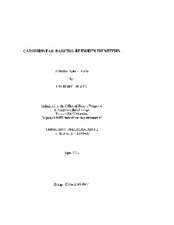Capoeiristas: dancing between identities
Abstract
Capoeira is an Afro-Brazilian martial art that is believed to have developed as a method of resistance for slaves in Brazil. Out of fear of their slaves' defensive abilities, this street fighting was outlawed. As a result, the slaves played music to accompany their fights disguising it as dance and thus, capoeira was born. True to the field of anthropology, I conducted an ethnographic study on two capoeirista groups in Austin. Capoeira is divided into two styles, regional and Angola; my study will focus primarily on capoeira Angola. Library research on capoeira revealed a strong connection between the art's practitioners and its African heritage. Therefore, I was surprised to find the classes I attended to be comprised of predominately white middle-class students. I also observed that the two groups I was interacting with exhibited very different characteristics and theoretical orientations in relation to training procedures. Consequently, I began to examine the process of identity formation. First, I defined identity as the psychological packages of qualities exhibited, endorsed and valued by the subject. My next task was to postulate hypotheses to explain the attraction of non-Africans to such an ethnic art. I formulated five different hypotheses including identification with a romantically un-rooted lifestyle, a rejection of Western society's superficial dichotomies, a quest for a new culture to rally around due to a sense of nonconformity with general "American" culture, a search for a community network, and finally, a search for something new and exotic. I found the emic, native, point of view to best support the search for a community network hypothesis. However, my etic view, the outsider's opinion, has discerned something deeper that holds these people together. My empirical evidence best supports the ideas that one of my contact groups falls into the search for something new and exotic hypothesis, but the other group falls into the quest for an alternative culture category. This research has also had a profound effect on me personally, especially due to my experiences as a dancer. This study, I hope, will be expanded in order to test the applicability of my hypotheses to the capoeira culture at large.
Description
Due to the character of the original source materials and the nature of batch digitization, quality control issues may be present in this document. Please report any quality issues you encounter to digital@library.tamu.edu, referencing the URI of the item.Includes bibliographical references (leaves 39-41).
Citation
Miller, Lauren E (2003). Capoeiristas: dancing between identities. Texas A&M University. Available electronically from https : / /hdl .handle .net /1969 .1 /ETD -TAMU -2003 -Fellows -Thesis -M52.


